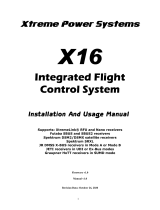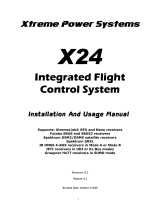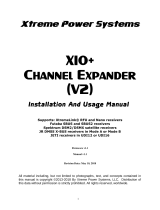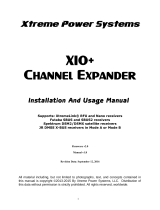
PRIVILEGED AND CONFIDENTIAL PROPERTY OF
HORIZON HOBBY, LLC
Specification for Spektrum
Remote Receiver Interfacing
Enabling Use of Spektrum
Remotes
in Third-Party Products
Rev A
2016 April 12
U
sing the Spektrum Remote Receivers in
Flight Controllers

Spektrum Remote Receiver Interfacing
Page 1 Rev P3
Specification for Spektrum
Remote Receiver Interfacing
1 INTRODUCTION
The market has a number of products which piggyback on Spektrum’s proven reliable RF system by
interfacing their flight control products directly to our remote receivers. The result is that many of
these products do not properly implement the interface, relying on faulty assumptions and incomplete
information as a result of the reverse engineering process.
2 AUDIENCE
This document is intended to assist hobbyists and flight control vendors to implement code and
hardware which functions according to the protocol. A certain degree of electronics and firmware
competency is necessary for proper implementation. The reader will need to self-determine their
ability to properly implement the protocol.
3 RELATED DOCUMENTATION
All necessary technical information is contained within this document, including diagrams and source
code guidance.
4 LEGAL INFORMATION
This document does NOT contain any proprietary information. This document is subject to revision and
does not constitute a commitment by Horizon Hobby to add support for any documented devices nor is
it guaranteed to be error-free.
All correspondence regarding this document shall be through the Horizon Hobby legal department:
Horizon Hobby, LLC, Legal Department, 4105 Fieldstone Road, Champaign, Illinois 61822 USA.
5 APPLICATION REQUIREMENTS
The requirements to create a robust RF link vary by application, installation, and flight range. In
general longer range requirements (beyond park flying distances), and installations that contain
substantial carbon fiber and metal components will require the use of more than one remote receiver
oriented 90 degrees from each other. Preference should be given to airframe installation locations with
line of sight access to the transmitter at all times (in all airframe orientations) and without direct
interference from metal or carbon fiber components.
6 ELECTRICAL DATA
The interface to the remote receivers is a 3-wire bus. Pins are as noted in the photo below.
Pin Color Purpose
1 Orange 3.3VDC +/-5%, 20mA max
2 Black GND
3 Gray DATA

Spektrum Remote Receiver Interfacing
Page 2 Rev P3
The connector used in the Spektrum remote is JST part number S3B-ZR(LF)(SN) (Digikey part 455-
1670-ND). This mates to part JST ZHR-3 (Digikey 455-1160-ND). See JST for other mating
components.
7 HARDWARE-LEVEL PROTOCOL
7.1 Normal Operation
In normal operation, the Spektrum remotes issue a 16-byte data packet every 11ms or 22ms, depending
upon the selected protocol. The packet is transmitted at 125000bps, 8 bits, No parity, 1 stop (8N1).
For those UARTs which are not capable of that speed, they will also work at the more-standard
115200bps. When no data is received, the remote does not transmit anything. It will count missed
frames, and the updated count will be sent after the next packet has been received but not until.
If a failsafe operation is to be implemented, it must be triggered by repeated packet losses as timed by
the flight controller. In Spektrum products this is a one-second timer which is reset upon the reception
of any packet by the microcontroller. This provides one second of “hold last” signals. When the timer
expires, the microcontroller executes the failsafe function defined for each channel.
7.2 Binding
A remote receiver is put into bind mode by issuing a series of pulses at power-up. The number of
pulses determines the types of binds allowed, as well as the “internal” or “external” mode of operation
(see below). The SPM9545 DSM2 remote does not accept DSMX bind commands. The DSMX
remotes SPM9645 and SPM9646 support both DSMX and DSM2, and will automatically select DSM2
or DSMX as available in the transmitter. Also, as DSMX always uses 2048 mode, the increased
precision gives the ability for an improved end-user experience. Note that DSM2 transmitters are not
available in Europe, although users still operate them. For these reasons, we strongly recommend using
only DSMX bind commands and DSMX remote receivers.
To put a receiver into bind mode, within 200ms of power application the host device needs to issue a
series of falling pulses. The number of pulses issued selects which bind types will be accepted from
the transmitter. Selecting the 11ms mode automatically allows either 11ms or 22ms protocols to be
used. Selecting DSMX will automatically allow DSM2 to be used if the transmitter is unable to

Spektrum Remote Receiver Interfacing
Page 3 Rev P3
support DSMX. For this reason, we recommend that 11ms DSMX be used (9 (“internal”) or 10
(“external”) pulses).
DSMX Bind Modes:
Pulses Mode Protocol Type
7 Internal DSMx 22ms
8 External DSMx 22ms
9 Internal DSMx 11ms
10 External DSMx 11ms
DSM2 Bind Modes (not recommended):
Pulses Mode Protocol Type
3 Internal DSM2 22ms
4 External DSM2 22ms
5 Internal DSM2 11ms
6 External DSM2 11ms
7.3 Internal and External Modes
In the Spektrum system, receivers bind as either a master (the “A” receiver) or auxiliary (the B, R, and
L receivers). In most receivers the A is internal to the receiver body, hence the “internal” moniker. The
important detail is that the A remote controls the bind process for the entire system, in that it is the only
remote which negotiates with the transmitter to establish a link. For that reason, it is absolutely
imperative that only one remote in your system be the “internal” or “A” remote. You may bind as
many other receivers as desired at the same time, but they must all be bound in the “external” mode.
All remotes must be in bind mode for them to bind to the transmitter. Any remote not in bind mode
will not bind.
If no remote is put into the internal mode, the transmitter will report Bind Failed and a link will not be
established. If multiple remotes are in internal mode, the results cannot be predicted.
When a remote is put into bind mode, it retains its previously bound information until the bind is
complete, at which time it saves the new bind information. For this reason, if you put a remote into
bind mode and then cancel the bind (which can only be done by removing power), it will retain the
information from the previous bind.
8 DATA FORMATS
Spektrum remote receivers output data in several different formats based upon protocol, speed, and
internal/external status.
For internal remotes, the first byte (fieldname “system” in Section 8.3 below) indicates the protocol
selected, which will also specify the data format used by for all remotes. Also for internal remotes, the
second byte (fieldname “fades” in Section.3 below) indicates the fade count (missed frames for this
remote). The remaining 14 bytes are the data packet.
For external remote, the first two bytes (fieldname “fades” in Section 8.4 below) indicate the fade
count, and the remaining 14 bytes are the data packet.

Spektrum Remote Receiver Interfacing
Page 4 Rev P3
Note that the internal remote provides the key for proper utilization of the data streaming from all
remotes. All remotes are in 1024 mode, or all remotes are in 2048 mode.
The 14-byte data packet is either 1024 or 2048 servo data. DSM2/22 is the only 1024 packet; all others
use 2048.
All data fields are big-endian, that is, the MSB is transmitted before the LSB. Bit 0 is the lsb, bit 15
is the msb.
8.1 Servo Field 1024 Mode
This format is used only by DSM2/22ms mode. All other modes use 2048 data.
Bits 15-10 Channel ID
Bits 9-0 Servo Position
#define MASK_1024_CHANID 0xFC00
#define MASK_1024_SXPOS 0x03FF
8.2 Servo Field 2048 Mode
This format is used by all protocols except DSM2/22ms mode.
Bits 15 Servo Phase
Bits 14-11 Channel ID
Bits 10-0 Servo Position
#define MASK_2048_CHANID 0x7800
#define MASK_2048_SXPOS 0x07FF
8.3 Message Structure Internal Remote
typedef stuct
{
UINT8 fades;
UINT8 system;
UINT16 servo[7];
} INT_REMOTE_STR;
The “system” field will only contain certain values. Any value other than these should be ignored and
the unit should behave in a mode appropriate for not having bound.
Allowed System Field Values
Value Protocol
0x01 22MS 1024 DSM2
0x12 11MS 2048 DSM2
0xa2 22MS 2048 DSMS
0xb2 11MS 2048 DSMX

Spektrum Remote Receiver Interfacing
Page 5 Rev P3
8.4 Message Structure External Remote
typedef struct
{
UINT16 fades;
UINT16 servo[7];
} EXT_REMOTE_STR;
8.5 Channel ID Information
The content of each 16-byte packet is determined by the transmitter, and may vary according to a
number of factors such as bind type, aircraft type, and special modes such as X-Plus operation. In
order to transmit all the channels possible, the transmitter makes determinations during operation which
make it mandatory that the flight controller properly parse the channel data in each packet. One cannot
assume that a packet will have the same data in the same index in the servo[] array in each frame; it is
necessary that the Channel ID field be examined for each index in every packet.
Channel Identifiers
ID Name
0 Throttle
1 Aileron
2 Elevator
3 Rudder
4 Gear
5 Aux 1
6 Aux 2
7 Aux 3
8 Aux 4
9 Aux 5
10 Aux 6
11 Aux 7

Spektrum Remote Receiver Interfacing
Page 6 Rev P3
9 Servo Position Values
To ensure consistency across implementation in multiple devices, the following interpretation of
“Servo Position” data should be followed.
9.1 “Servo Position” Ranges
A full range of “Servo Position” data ranges from 0 to 1024 or 0 to 2048 depending on the bind type.
These limits are equivalent to a ±150% travel setting in AirWare.
This full range translates to a range of 1194µs which when applied to a PWM servo signal equals
903µs to 2097µs
At ±100% travel, the data range is equivalent to a “Servo Position” data range of approximately 341 to
1707 which translated to PWM equals 1102µs to 1898 µs
9.2 1024 Mode Scaling
In a 1024 resolution link, the PWM pulse should be calculated as follows.
PWM_OUT = (ServoPosition x 116.6µs) + Offset
• PWM_OUT - the pulse length that is output to the servo or motor in µs.
• ServoPosition - satellite data received for a specific servo/motor which ranges from 0 to 2048
• 116.6 - a constant used to achieve a full pulse range of 1194µs
• Offset – offset to center the pulse at 1500µs. Theoretically, this should be 903µs, but the actual
value to achieve a 1500µs
9.3 2048 Mode Scaling
In a 2048 resolution link, the PWM pulse should be calculated as follows.
PWM_OUT = (ServoPosition x 58.3µs) + Offset
• PWM_OUT - the pulse length that is output to the servo or motor in µs.
• ServoPosition - satellite data received for a specific servo/motor which ranges from 0 to 2048
• 58.3µs - a constant used to achieve a full pulse range of 1194µs
• Offset – offset to center the pulse at 1500µs. Theoretically, this should be 903µs, but the actual
value to achieve a 1500µs

Spektrum Remote Receiver Interfacing
Page 7 Rev P3
REVISION HISTORY
Rev Date Author Description
P0 2015-05-07 AK Initial authoring.
P1 2015-05-13 AK Added image, corrected discrepancies vs. source documents.
P2 2015-05-20 VA P1 revised and rewritten, P2 added 200ms
P3 2015-10-23 TK Revised internal struct format and channel ID masks
P4 2015-10-28 MFA Added Servo Position Values section.
A 2016-04-12 AK Clean up for publication.
-
 1
1
-
 2
2
-
 3
3
-
 4
4
-
 5
5
-
 6
6
-
 7
7
-
 8
8
Spektrum SPM4648 Owner's manual
- Type
- Owner's manual
- This manual is also suitable for
Ask a question and I''ll find the answer in the document
Finding information in a document is now easier with AI
Related papers
-
Spektrum DX18 Owner's manual
-
Spektrum DX10t 10-Channel Transmitter/Receiver OnlyMode 1-4 User manual
-
Spektrum DX18 18 Channel System Generation 2 Md2 Owner's manual
-
Spektrum AR8020T 8 Channel Telemetry Receiver Owner's manual
-
Spektrum SPMAR6610T Owner's manual
-
Spektrum SPM8200 Owner's manual
-
Spektrum DX18T 18-Channel Transmitter Only Mode 1-4 User manual
-
Spektrum iX12iX12 12 Channel Transmitter Only Owner's manual
-
Spektrum SPMAR9350 User manual
-
Spektrum SPMAR7210BX User manual
Other documents
-
HobbyKing ORANGERX DEVO User manual
-
 Xtreme Power Systems X16 Integrated Flight Control System Installation and Usage Manual
Xtreme Power Systems X16 Integrated Flight Control System Installation and Usage Manual
-
 Xtreme Power Systems X24 Integrated Flight Control System Installation and Usage Manual
Xtreme Power Systems X24 Integrated Flight Control System Installation and Usage Manual
-
 Xtreme Power Systems X10+ Channel Expander V2 Installation and Usage Manual
Xtreme Power Systems X10+ Channel Expander V2 Installation and Usage Manual
-
 Xtreme Power Systems X10+ Channel Expander Installation and Usage Manual
Xtreme Power Systems X10+ Channel Expander Installation and Usage Manual
-
ParkZone Archer User manual











